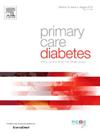Effects of intensive blood pressure control on cardiovascular outcomes in patients with diabetes: A systematic review and meta-analysis
IF 2.3
4区 医学
Q3 ENDOCRINOLOGY & METABOLISM
引用次数: 0
Abstract
Background
Hypertension frequently coexists with diabetes, affecting over two-thirds of diabetic patients and significantly increasing cardiovascular (CV) risk. While blood pressure (BP) reduction offers substantial benefits in this population, the optimal systolic blood pressure (SBP) target remains controversial. This meta-analysis evaluates the effects of intensive SBP lowering (<130 mmHg) versus standard therapy (<150 mmHg) on key CV outcomes in hypertensive patients with diabetes.
Methods
This systematic review and meta-analysis adhered to PRISMA guidelines and included randomized controlled trials (RCTs) assessing SBP targets in diabetic patients. Electronic databases were searched through December 2024. Hazard ratios (HRs) for all-cause mortality, CV death, heart failure (HF), stroke, major adverse cardiovascular events (MACE), and major coronary heart disease events were pooled using a random-effects model. Risk of bias was evaluated using the Cochrane Risk of Bias Tool.
Results
Four RCTs involving 21,169 patients were included. Intensive SBP control significantly reduced stroke (HR: 0.71; p = 0.01), HF (HR: 0.69; p = 0.02), CV death (HR: 0.76; p = 0.04), and MACE (HR: 0.82; p < 0.0001) but showed no significant impact on all-cause mortality (HR: 0.90; p = 0.24) or major coronary heart disease events (HR: 0.93; p = 0.16). Heterogeneity was minimal across outcomes.
Conclusion
Intensive BP control reduces stroke, HF, CV death, and MACE in hypertensive diabetic patients, highlighting its role in CV risk management. Future research should explore subgroup effects.
强化血压控制对糖尿病患者心血管结局的影响:一项系统综述和荟萃分析
背景:高血压经常与糖尿病共存,影响超过三分之二的糖尿病患者,并显著增加心血管(CV)风险。虽然降低血压(BP)对这一人群有实质性的好处,但最佳收缩压(SBP)目标仍然存在争议。方法:本系统综述和荟萃分析遵循PRISMA指南,纳入了评估糖尿病患者收缩压目标的随机对照试验(rct)。电子数据库被搜索到2024年12月。采用随机效应模型汇总全因死亡率、心血管死亡、心力衰竭、中风、主要不良心血管事件和主要冠心病事件的风险比(hr)。使用Cochrane偏倚风险工具评估偏倚风险。结果:纳入4项随机对照试验,共21,169例患者。强化收缩压控制可显著减少卒中(HR: 0.71;p = 0.01),HF (HR: 0.69;p = 0.02),CV死亡(HR: 0.76;p = 0.04),MACE (HR: 0.82;p 结论:强化血压控制可降低高血压糖尿病患者的卒中、心衰、CV死亡和MACE,突出其在CV风险管理中的作用。未来的研究应探索亚组效应。
本文章由计算机程序翻译,如有差异,请以英文原文为准。
求助全文
约1分钟内获得全文
求助全文
来源期刊

Primary Care Diabetes
ENDOCRINOLOGY & METABOLISM-PRIMARY HEALTH CARE
CiteScore
5.00
自引率
3.40%
发文量
134
审稿时长
47 days
期刊介绍:
The journal publishes original research articles and high quality reviews in the fields of clinical care, diabetes education, nutrition, health services, psychosocial research and epidemiology and other areas as far as is relevant for diabetology in a primary-care setting. The purpose of the journal is to encourage interdisciplinary research and discussion between all those who are involved in primary diabetes care on an international level. The Journal also publishes news and articles concerning the policies and activities of Primary Care Diabetes Europe and reflects the society''s aim of improving the care for people with diabetes mellitus within the primary-care setting.
 求助内容:
求助内容: 应助结果提醒方式:
应助结果提醒方式:


